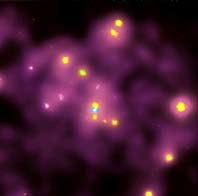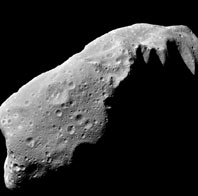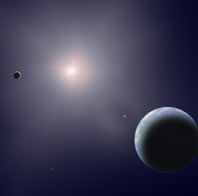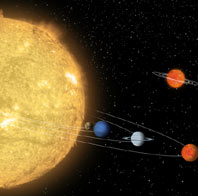Tiny Black Holes
by Charles Keeton and Arlie Petters
Black holes are among the oddest objects believed to populate
the universe. Long sought, they have recently been "found"
lurking in the centers of galaxies, tipping the scales at a
million to a billion times the mass of the sun. Now, just to
stir things up, enticing hints have come to the fore that
tiny black holes may exist, and if so, they may hold
the key to testing whether the universe has more to offer than
the three familiar spatial dimensions of length, width, and
height.
Tiny in this context means something around a billionth of a
billionth of the mass of the sun—a couple billion tons,
or the mass of a small asteroid. A black hole of this mass
would be about the size of an atomic nucleus. Physicists have
speculated that, when the universe was very young and hot,
copious numbers of miniature black holes may have been
produced. (To our knowledge, tiny black holes cannot form
today.)
Alive and well?
But would these "primordial" black holes still exist, roughly
14 billion years after the big bang? Surprisingly, the answer
depends on the number of spatial dimensions in the universe.
And the reason for that—bear with us—has
something to do with the fact that black holes are not,
strictly speaking, black.
Stephen Hawking famously discovered that black holes can lose
mass by emitting elementary particles. (Quantum mechanics
allows matter/antimatter pairs to spontaneously form and
quickly disappear just outside a black hole's event horizon.
If one particle falls in and the other flies away, it looks to
a distant observer like the black hole has emitted a
particle.) "Hawking radiation" should cause a black hole to
shrink and eventually evaporate. This process is basically
irrelevant for black holes the mass of our sun or larger, but
it's vital for their minute cousins.
In Einstein's theory of general relativity, which describes a
universe with three dimensions of space (plus one of time),
Hawking radiation would have caused all primordial black holes
smaller than a few hundred million tons to evaporate by now.
That could change, though, if the universe has more than three
spatial dimensions.
The idea of extra dimensions grew out of string
theory—which needs them to explain how the strings
vibrate—but it has taken on a life of its own. Whereas
string theorists traditionally assume that extra dimensions
are wrapped up so tight that they don't affect anything
besides strings, other physicists have begun to entertain the
notion that one or more of the extra dimensions may be large
enough to affect physics on scales we can measure.
A matter of dimension
One thought is that everything we know might be confined to a
three-dimensional membrane floating, like a strand of seaweed
in the ocean, in a larger universe that actually has four
spatial dimensions. Physicists Lisa Randall of Harvard and
Raman Sundrum of Johns Hopkins University have turned this
"braneworld" concept into a specific model that they and
others are examining as a possible alternative to Einstein's
general relativity.
In the Randall-Sundrum braneworld model, the fourth dimension
of space changes how gravity operates on small scales, which
changes the rate at which small black holes form and
evaporate. The upshot is that very tiny primordial black
holes—perhaps as small as a pound or two—may have
been able to survive to today and may even constitute some of
the exotic dark matter in the universe.
The question of whether tiny primordial black holes still
exist therefore represents a clear distinction between general
relativity and the Randall-Sundrum model. It could provide a
crucial way to distinguish between these competing theories of
the universe—if only we could figure out how to look for
primordial black holes.
Finding evidence
Well, we have developed a way to do just that. While studying
how the gravity from a black hole bends light rays, we
recently discovered that a primordial black hole would create
a rippling interference pattern in a passing light wave, much
in the same way that a rock in a stream impedes a passing
water wave.
Your neighbors could have a pet black hole, and you might not
realize it.
A close relationship exists between the mass of a black hole
and the wavelength of light it can affect. If the
Randall-Sundrum model is correct, tiny primordial black holes
could exist and produce interference patterns in light from
the short-wavelength, gamma-ray portion of the electromagnetic
spectrum. By contrast, if general relativity is right, no
primordial black holes below a few hundred million tons should
remain, and hence no interference patterns should appear in
gamma-ray light.
After calculating the interference effect, we scratched our
heads and asked each other, Is there any hope of measuring it?
We knew that tremendous natural explosions in deep space
called gamma-ray bursts produce light of the right wavelength.
The question was whether any telescope today could measure
this light.
It turns out that the perfect telescope is on the way: the
Gamma-ray Large Area Space Telescope (GLAST), which is
scheduled to be launched on a spacecraft in August 2007. A
joint effort among NASA, the U.S. Department of Energy, and
institutions in France, Germany, Japan, Italy, and Sweden,
GLAST will be exquisitely sensitive to high-energy gamma
rays—and able to measure interference effects from any
primordial braneworld black holes.
In the neighborhood?
Because it seemed relevant for GLAST—not to mention
fun—we tried to figure out where the nearest primordial
braneworld black holes might be. We were startled to realize
that they would be right in our backyard, astronomically
speaking: if they make up 1 percent of the dark matter in the
universe, thousands of tiny black holes may lie within our
solar system! Our immediate reaction was, "No, that can't be.
If black holes exist in the solar system, surely we would
know."
Actually, maybe not. The gravity from these black holes is not
very strong; you could add a few thousand of them to the solar
system without really changing the planets' orbits. You would
need to get within 12 feet of one of these black holes to feel
as much gravity as you normally feel here on Earth. So your
neighbors could have a pet black hole, and you might not
realize it. Not that they could hold onto it: as far as we
know, miniature black holes would not experience the atomic
forces that make matter solid, so they would pass right
through the planet.
An enormous idea
So we come away with the incredible thought that the solar
system—and the rest of the universe—might be
filled with tiny black holes, each carrying the signature of
the fourth dimension. And in the next year or two, GLAST
should make it possible to look for them. It is worth noting
that if we don't see the characteristic interference patterns
right away, it doesn't automatically mean braneworld gravity
is wrong; it could just mean primordial black holes are rare.
If we see even one case of interference, though, that's when
the fun begins. We would immediately know that tiny black
holes exist. We would need to analyze the data carefully
before drawing firm conclusions about gravity. But we would
dive in with gusto, knowing that we were on the trail of
something physically small but philosophically enormous. As
large, perhaps, as a whole new dimension of space.






